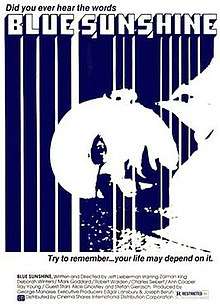Blue Sunshine (film)
Blue Sunshine is a 1978 American horror film written and directed by Jeff Lieberman and starring Zalman King, Deborah Winters, Brion James, Alice Ghostly and Mark Goddard. The plot focuses on a series of random murders in Los Angeles, in which the only common link between the perpetrators is a mysterious batch of LSD that they had all taken years prior.
| Blue Sunshine | |
|---|---|
 Theatrical release poster | |
| Directed by | Jeff Lieberman |
| Produced by | George Manasse |
| Written by | Jeff Lieberman |
| Starring | Zalman King Deborah Winters Robert Walden Mark Goddard Brion James Charles Siebert |
| Music by | Charles Gross |
| Cinematography | Don Knight |
| Edited by | Brian Smedley-Aston Russ Kingston |
| Distributed by | Cinema Shares International |
Release date |
|
Running time | 94 mins. |
| Country | United States |
| Language | English |
| Budget | $550,000[1] |
Over the years, the film attracted a cult following,[2][3][4] and was released on special edition DVD by Synapse Entertainment in 2003. It has been shown at many film festivals since.[5]
Plot
During a party, Frannie Scott (Richard Crystal) croons a Sinatra song and playfully tries to kiss his friend's date, causing the friend to pull Frannie's hair, which unexpectedly comes off. The bald Frannie then has a psychotic break, brutally murders several party guests, and chases Jerry Zipkin (Zalman King) into the nearby road, where Frannie is hit and killed by a passing truck.
Jerry is wrongly accused of the murders and goes on the lam, trying to gather evidence to prove his innocence, helped by his friends Alicia Sweeney (Deborah Winters) and surgeon David Blume (Robert Walden). After learning about a similar sudden mass murder by a bald police officer, Jerry discovers that ten years prior, a group of college students had taken a new form of LSD called "Blue Sunshine," provided by dealer Ed Flemming (Mark Goddard), and are now suddenly losing their hair and becoming homicidal maniacs many years after their trips are over. Flemming, now a respected local politician running for Congress, lies and tells Jerry he never heard of Blue Sunshine. When Jerry visits Flemming's estranged wife, Wendy, he finds she is also bald and about to murder two children she is babysitting. Jerry saves the children by pushing the knife-wielding Wendy off her apartment balcony, but ends up wrongly accused of her murder as well.
Jerry schemes to prove that Blue Sunshine is causing homicidal psychosis by finding a past user of the drug who is still living and can be tested for chromosome damage caused by the drug. Armed with a paraldehyde dart gun, Jerry goes to a Flemming rally at a shopping mall, having learned that Flemming's campaign manager/ bodyguard Wayne Mulligan (Ray Young) was a heavy Blue Sunshine user. Before Jerry's arrival, the now-bald Wayne goes on a rampage through the mall discotheque, beating and terrorizing its patrons including a police detective and Alicia, and causing crowds to flee the mall in panic. Jerry tracks Wayne to an empty department store and paralyzes him with the dart gun. An on-screen epilogue states that Wayne was tested, found to have "extensive chromosomic aberrations", and confined to a sanitarium, and that 255 doses of Blue Sunshine are still unaccounted for.
Cast
- Zalman King as Jerry Zipkin
- Deborah Winters as Alicia Sweeney
- Mark Goddard as Edward Flemming
- Robert Walden as David Blume
- Charles Siebert as Detective Clay
- Ann Cooper as Wendy Flemming
- Ray Young as Wayne Mulligan
- Alice Ghostley as O'Malley's Neighbor
- Stefan Gierasch as Lt. Jennings
- Richard Crystal as Frannie Scott
- Bill Adler as Ralphie
- Barbara Quinn as Stephanie
- Adriana Shaw as Barbara O'Malley
- Bill Sorrells as Ritchie Grazzo
- Jeffrey Druce as Junkie
- Brion James as Tony
Production
Critical reception
AllMovie gave the film a mildly favorable review, calling it "too uneven to please a general audience" but "offers enough moments of interest for fans of horror films and offbeat cult items."[6]
Fawn Krisenthia of Cult Reviews wrote:
The movie gets a thumbs-up since quirky (Jeff) Lieberman directs. You know you are entering Lieberman’s world when the very movie title is spoken by his parrot. I imagine that Lieberman had a checklist for his 70s style movie, things that were popular at the time. For example, random car chase? Check. Discothèque? Check. Conspiracy theory? Check. Obligatory ‘This movie is based on true events’ disclaimer at the end of the film? Check.[4]
Budd Wilkins of Slant Magazine gave the film two and a half stars out of five and called it "an unjustly neglected genre classic that delivers a deft fusion of horror-movie tropes, social satire, and cult-film weirdness."[7] In the Village Voice, Simon Abrams wrote:
Shot at the end of 1976 and into early 1977, the influential film gradually amassed an eclectic but hardcore following over the years. Its champions include Gremlins filmmaker Joe Dante and even the late critic Andrew Sarris, who praised “Lieberman’s directional talent” and the film’s “intriguing premise” in this paper when Blue Sunshine screened on TV in 1982.[5]
References
- Smith, Richard Harland (2013-05-10). "Blue Sunshine". Turner Classic Movies. TCM Underground. Archived from the original on 2014-12-17. Retrieved 2020-01-31.
- Nelson, Michael Curtis (2011-10-26). "People Lose Their Hair -- and Their Minds -- in 'Blue Sunshine'". PopMatters. Retrieved 2017-11-01.
- Alexander, Chris (2015-10-30). "Interview: Director Jeff Lieberman Talks BLUE SUNSHINE 4K Restoration". Comingsoon.net. Retrieved 2017-11-01.
- Krisenthia, Fawn. "Blue Sunshine". Cult Reviews. Retrieved 5 August 2011.
- Abrams, Simon. "The 'Sunshine' Cult: Jeff Lieberman's Far-Reaching Rays at Anthology". The Village Voice. Retrieved 15 August 2012.
- Guarisco, Donald. "Blue Sunshine - Review - AllMovie". AllMovie. Retrieved 24 July 2012.
- Wilkins, Budd (2011-09-20). "Blue Sunshine". Slant Magazine. Retrieved 2017-11-01.